![]()
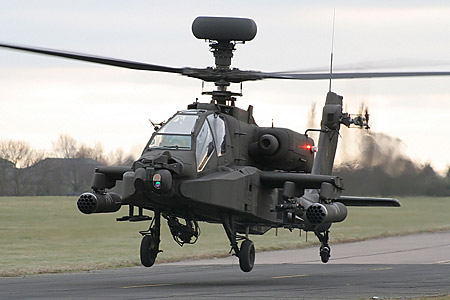 Part
eight: Apache reservation by
Gary Stedman
Part
eight: Apache reservation by
Gary Stedman
Dave Eade wrote part seven of the Wattisham Chronicles way back in early 1999 - in the seven years since then the aviation scene in East Anglia has changed beyond virtually all recognition. Fortunately, in this time of change, the future of Wattisham as a centre of Army Air Corps aviation in the UK has remained largely beyond any real doubt - although few could have predicted the operational deployment of Apache would become quite the drawn-out saga it has! So, with Dave's kind permission and the gentle persuasion of the Air-Scene UK editor, I will bring the story of Wattisham - from a local aviation enthusiast's viewpoint - up to date and I hope this new chapter will maintain Dave's excellent standards.
August 2000 saw the first visit to the base by a British-built Apache, this being an unplanned nightstop due to a 'tech', giving the locals a chance to see what was to come in the near future. It was to be several more years however, before the sight and sound of the Apache was to become familiar in the Suffolk skies. The first pair of Apaches for Wattisham's own 3 Regiment were delivered to the base in January 2005, although initially they were to be flown by the Air Manoeuvre Training Advisory Team (AMTAT) as the first Wattisham-based Apache crews were down at Middle Wallop on the conversion to type course. Deliveries - mainly from storage at RAF Shawbury - continued throughout 2005 and by late summer enough were on strength that visitors to the fence could usually bank on seeing daily Apache operations from the flightline.
 While
the arrival of the Apache AH1 (to use its correct name) with the Army
Air Corps heralded the addition of a real attack helicopter to UK forces
it also signalled the beginning of the end for the venerable Gazelle,
at least in AAC service. In preparation for the changes ahead, the mixed
Gazelle/Lynx squadrons had already switched to single type units prior
to Apache conversion, and to complicate matters further, the wheeled AH9
Lynxes flown by a squadron within each of the two regiments had been replaced
with further skidded AH7s, leaving Wattisham with - in theory - a uniform
fleet. Gazelles began to be transferred out in 2005, as 662 and then 663
Squadrons became pure Apache units, and by late 2006 the only Gazelles
remaining at Wattisham were flown by 654 Squadron of 4 Regiment, their
days certainly numbered. A more subtle change to be seen around the base
during 2005 was the removal of the boxy TOW launchers from the Lynx AH7s
as the helicopter lost the anti-armour role that it was probably ill-suited
for anyway and became a straightforward light battlefield support helicopter.
While
the arrival of the Apache AH1 (to use its correct name) with the Army
Air Corps heralded the addition of a real attack helicopter to UK forces
it also signalled the beginning of the end for the venerable Gazelle,
at least in AAC service. In preparation for the changes ahead, the mixed
Gazelle/Lynx squadrons had already switched to single type units prior
to Apache conversion, and to complicate matters further, the wheeled AH9
Lynxes flown by a squadron within each of the two regiments had been replaced
with further skidded AH7s, leaving Wattisham with - in theory - a uniform
fleet. Gazelles began to be transferred out in 2005, as 662 and then 663
Squadrons became pure Apache units, and by late 2006 the only Gazelles
remaining at Wattisham were flown by 654 Squadron of 4 Regiment, their
days certainly numbered. A more subtle change to be seen around the base
during 2005 was the removal of the boxy TOW launchers from the Lynx AH7s
as the helicopter lost the anti-armour role that it was probably ill-suited
for anyway and became a straightforward light battlefield support helicopter.
663 Squadron
had previously operationally deployed with the Gazelle and Lynx/TOW combination
in early 2003 as part of Operation Telic, the UK effort in the invasion
of Iraq. Forewarned, the squadron had spent much of Christmas 2002 preparing
its aircraft for the upcoming operation only to find them 'acquired' by
the Royal Marines squadron (847 NAS) and having to start over again. The
squadron successfully completed its operational deployment, despite suffering
the all-too-common equipment shortages and the usual bureaucratic manner
in 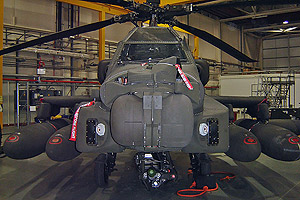 which
Her Majesty's forces are expected to go to war; replacing worn Lynx rotor
blades from the single-source manufacturer at their inflated rates when
a simple in-theatre fix was available is one well-known example that readily
comes to mind.
which
Her Majesty's forces are expected to go to war; replacing worn Lynx rotor
blades from the single-source manufacturer at their inflated rates when
a simple in-theatre fix was available is one well-known example that readily
comes to mind.
Even prior to the Apache, the AAC conducted a high percentage of its flight training at night. Although much of this is flown at military facilities like the STANTA battle area and RAF Woodbridge, it is still necessary to operate frequently over local areas and low-flying is simply part of the required training. With the further increased emphasis on night operations the Apache brings, the issue became unavoidable (aided by some shameless local political points-scoring gleefully recorded in the local media), so the AAC took the PR initiative and 3 Regiment hosted Wattisham's first open day in July 2005 for many years. Details can be found here, but suffice is to say it was a well presented and organised event that was supported enthusiastically by local residents and did Army relations with the local community a power of good. A year on, hopes that such a successful event would become an annual fixture (indeed, it seemed to be presented as such at the time) appear to have been dashed with no public event in 2006 - the Regiments are simply too busy with a heavy programme of exercises and forthcoming deployments.
 |
|
During
2005 the Wattisham Airfield Memorial was erected and unveiled directly
opposite Crash Gate 2, overlooking the airfield. Engraved with details
of the operations flown from Wattisham between 1939 and 1945, the
stone stands as a memorial to the RAF and USAAF crews who never
returned during those years.
|
So far we've
looked at the Air Army Corps and the major changes that have taken place
within the last few years, and those that are still to come, but it must
not be forgotten that both the Suffolk Police and the Royal Air Force
still operate helicopters from Wattisham. 'B' Flight, 22
Squadron's two Sea King HAR3As, continues to maintain constant Search
and Rescue cover for South-east England from Wattisham. Two newsworthy
events involving the flight occurred in the first half of 2006; February
saw a freshly-cleaned Sea King land in the grounds of Buckingham Palace
to attend a evening reception with the Queen, while still remaining 'on
call', and in June the small unit reached the two-thousand operational
sortie milestone in just twelve years at Wattisham. This impressive figure
was reached in quite dramatic fashion when fire took hold of the 'Sealand'
platform located just off the coast from Felixstowe, the residents being
rescued by winch. The long-term future of 'B' Flight - like all RN/RAF
SAR helicopter units - looks bleak, with the MoD stating that the replacement
for the ageing Sea King fleet would be provided by 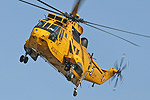 yet
another dreaded Private Finance Initiative, seeking to cut costs (which
of course, rarely actually happens), while maintaining the pretence that
the quality of service is unaffected. The fact that the Sea King urgently
requires a replacement is obviously unavoidable, as fleet availability
has become a major problem in recent years, yet many contend that military
SAR crews are a priceless national asset that should be trained and managed
by the Armed Forces themselves, not laid open to the commercial markets.
yet
another dreaded Private Finance Initiative, seeking to cut costs (which
of course, rarely actually happens), while maintaining the pretence that
the quality of service is unaffected. The fact that the Sea King urgently
requires a replacement is obviously unavoidable, as fleet availability
has become a major problem in recent years, yet many contend that military
SAR crews are a priceless national asset that should be trained and managed
by the Armed Forces themselves, not laid open to the commercial markets.
Although certainly the smallest flying unit located at Wattisham, Suffolk Police's Air Support Unit with their Eurocopter EC135 cannot lay claim to being the quietest! Its high pitched and distinctive sound can regularly be heard around the county, as it hovers over various incidents in support of officers on the ground. Since 2000, the ASU have flown from one of the old Hardened Aircraft Shelters on the north site and, after initially receiving a somewhat bad press, it looks like the leased aircraft has proved its worth and is here to stay. In particular, the aircraft provided invaluable during the Suffolk Police investigation into the Ipswich murders in late 2006.
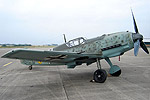 During
2005/6 two old wartime adversaries temporarily made Wattisham their home,
although only one was to actually take to the skies in the UK before moving
on to its new owner. Local warbird restorer Hawker Restorations Ltd found
Wattisham's hard runway to their liking, and completed final restoration
work at the airfield on a genuine Bf109 E-3 that had originally crashed
on the French coast in 1940. Restored with a genuine Daimler Benz 601A
engine, this proved to be the aircraft's undoing in so much as test flying
from Wattisham was concerned, as difficulties with the engine resulted
in the aircraft being shipped to its US owner unflown. Despite initial
secrecy early in 2005, the 109's presence at Wattisham became known well
enough that it was sportingly placed on static display at the 2005 open
day.
During
2005/6 two old wartime adversaries temporarily made Wattisham their home,
although only one was to actually take to the skies in the UK before moving
on to its new owner. Local warbird restorer Hawker Restorations Ltd found
Wattisham's hard runway to their liking, and completed final restoration
work at the airfield on a genuine Bf109 E-3 that had originally crashed
on the French coast in 1940. Restored with a genuine Daimler Benz 601A
engine, this proved to be the aircraft's undoing in so much as test flying
from Wattisham was concerned, as difficulties with the engine resulted
in the aircraft being shipped to its US owner unflown. Despite initial
secrecy early in 2005, the 109's presence at Wattisham became known well
enough that it was sportingly placed on static display at the 2005 open
day.
As previously mentioned, the runway and landing aids have been maintained, and it was always intended that RAF transport aircraft would be able to operate directly from the base in support of the Army, although the positioning of the new hangars appears to have complicated this somewhat. Initially, it was rumoured locally that the new management was very hostile to visiting aircraft, although in recent years this (if true) appears to have eased somewhat and an increasingly expanding mix of aircraft can be seen on a regular basis. RAF Chinooks and C-130s have become quite common, along with most other UK military helicopter types and the base is frequently used as a fuelling stop when crossing into Europe. Harriers from RAF Cottesmore used Wattisham as a Forward Operating Location for a week long exercise in September 2003, and the placing of a Forward Arming and Refuelling Point (FARP) for RAF and AAC helicopters in one of the HAS sites during exercises has become standard practice.
|
Not
just Army Air Corps - some visitors in recent years
|
 |
 |
 |
 |
 |
 |
 |
Visits by
fast jets are 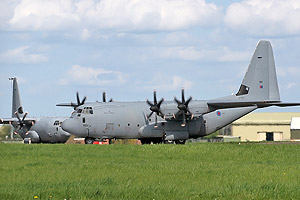 admittedly
rare, but do occur with a gradually increasing frequency. Early 2005 saw
the first appearance by a type originally intended to be based at Wattisham,
when a RAF Typhoon carried out an overshoot, although Air Traffic's word
has to be taken for this as it was completely dark at the time - but I
did manage to photograph the strobes during this historic occasion! By
the end of 2006, Typhoons were becoming quite regular visitors to the
circuit. Jaguars and Tornados will do the occasional practice overshoot,
while Hawks have been known to drop in on training exercises. Foreign
visitors are generally transiting rotary types and the odd VIP and light
transport passing through, but the airshow season usually brings through
Belgian Air Force Fouga Magisters during the summer. After a gap of fifteen
years, the Czech Air Force was back at Wattisham with a pair of helicopters
- a Mi-17 and Mi-24 night stopping in September en-route to Scotland for
the Leuchars Airshow. Rumour has it the crews wasted no time in getting
to the bar!
admittedly
rare, but do occur with a gradually increasing frequency. Early 2005 saw
the first appearance by a type originally intended to be based at Wattisham,
when a RAF Typhoon carried out an overshoot, although Air Traffic's word
has to be taken for this as it was completely dark at the time - but I
did manage to photograph the strobes during this historic occasion! By
the end of 2006, Typhoons were becoming quite regular visitors to the
circuit. Jaguars and Tornados will do the occasional practice overshoot,
while Hawks have been known to drop in on training exercises. Foreign
visitors are generally transiting rotary types and the odd VIP and light
transport passing through, but the airshow season usually brings through
Belgian Air Force Fouga Magisters during the summer. After a gap of fifteen
years, the Czech Air Force was back at Wattisham with a pair of helicopters
- a Mi-17 and Mi-24 night stopping in September en-route to Scotland for
the Leuchars Airshow. Rumour has it the crews wasted no time in getting
to the bar!
As mentioned
in part seven, spotting - and photographing - the daily AAC movements
can be quite difficult. Most rotary movements rarely keep to the runway
centreline, and most based helicopters will go 'south side', cutting the
runway out and air taxi direct to the ASP. That said, with some patience,
a little luck and some local knowledge, photographs from both ends of
the runway are perfectly obtainable. In this respect, the Apache is actually
the most photogenic of the Wattisham residents, as generally they will
approach/depart runway heading - just don't bother trying to photograph
one in anything less than perfect light! Crash Gate 2 remains the usual
meeting point for local enthusiasts to catch up on the local gossip, although
'number crunchers' will need a 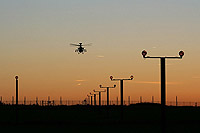 powerful
scope to read off Apache serials on the ASP from there. It can be done
however - or so I'm told! Occasionally the local helicopters will venture
closer to the northern fence line and Crash Gate 2 for slope training
or hover checks, although generally it is not a favoured location and
observations from here are usually quite distant.
powerful
scope to read off Apache serials on the ASP from there. It can be done
however - or so I'm told! Occasionally the local helicopters will venture
closer to the northern fence line and Crash Gate 2 for slope training
or hover checks, although generally it is not a favoured location and
observations from here are usually quite distant.
So what sort of attitude can a visiting spotter, hoping to see a few Apaches, expect from the Army given the current world climate? Well, prior to the Apache's arrival interest in AAC operations from Wattisham was virtually non-existent from even the local enthusiast community - we can be a fickle bunch and the Gazelle and Lynx seemed a poor substitute for a flight of Phantoms! Few bothered to peer through the fence, let alone attempt to get a picture unless something unusual was about. The Apache has changed this, and the local network of spotters has gradually returned to the fence and interest in the base and its operations is at an all-time high since the AAC moved in. Initially the Army seemed rather mystified when enthusiasts began to reappear in numbers on the perimeter fence, and a few attempts at moving people on have taken place. Happily, attitudes seem to have changed somewhat in the first half of 2006, with recent contact between personnel and spotters of a far more friendly nature. Indeed, the author has had more than one Apache crew pose for his camera recently! A good relationship can only be of benefit to both the AAC and spotters alike, and there seems no reason why it cannot develop further.
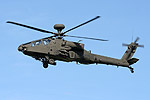 With
difficult and dangerous deployments to Afghanistan and perhaps Iraq planned
in early 2007, both AAC regiments spent much of 2006 in a series of near
back-to-back exercises and deployments. At the time of writing, 3 Regiment
is still undergoing conversion to the Apache and will deploy to replace
9 Regiment in Afghanistan when ready. First indications from the Dishforth
detachment are that the aircraft is performing well, despite the harsh
conditions and poor serviceability back in the UK (one only has to listen
to the number of 'aborted' training flights). Initially there was some
doubt as to whenever 4 Regiment would also convert to the Apache/Lynx
combination and the Regiment has recently received some Lynx AH9s back
again after transferring them out last year. Doubt ended, however, when
the first Apaches for the unit were delivered in late 2006 and their future
crews have started conversion at Middle Wallop. Indeed, all the frontline
Apache units will be centralised at Wattisham during this summer, 656
and 664 Squadrons will move to Suffolk and two Lynx helicopter units,
659 and 669 Squadrons, will go north to Dishforth as the AAC attempts
to streamline types and locations as much as is possible.
With
difficult and dangerous deployments to Afghanistan and perhaps Iraq planned
in early 2007, both AAC regiments spent much of 2006 in a series of near
back-to-back exercises and deployments. At the time of writing, 3 Regiment
is still undergoing conversion to the Apache and will deploy to replace
9 Regiment in Afghanistan when ready. First indications from the Dishforth
detachment are that the aircraft is performing well, despite the harsh
conditions and poor serviceability back in the UK (one only has to listen
to the number of 'aborted' training flights). Initially there was some
doubt as to whenever 4 Regiment would also convert to the Apache/Lynx
combination and the Regiment has recently received some Lynx AH9s back
again after transferring them out last year. Doubt ended, however, when
the first Apaches for the unit were delivered in late 2006 and their future
crews have started conversion at Middle Wallop. Indeed, all the frontline
Apache units will be centralised at Wattisham during this summer, 656
and 664 Squadrons will move to Suffolk and two Lynx helicopter units,
659 and 669 Squadrons, will go north to Dishforth as the AAC attempts
to streamline types and locations as much as is possible.
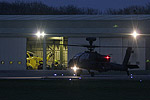 Wattisham's
future looks secure for the long-term - with Apache well on the way to
being fielded, the Army Air Corps seem set to be flying from Wattisham
for many years to come. Part nine may be a while!
Wattisham's
future looks secure for the long-term - with Apache well on the way to
being fielded, the Army Air Corps seem set to be flying from Wattisham
for many years to come. Part nine may be a while!